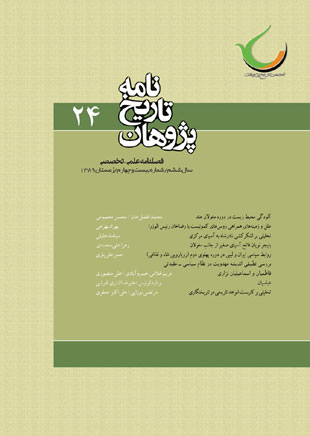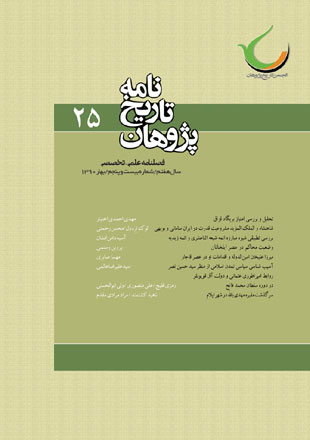فهرست مطالب

فصلنامه نامه تاریخ پژوهان
پیاپی 24 (زمستان 1389)
- بهای روی جلد: 30,000ريال
- تاریخ انتشار: 1390/05/01
- تعداد عناوین: 8
-
صفحه 152
-
Page 4In the present paper a preliminary attempt is made to explore the “Pollution of the Environment” in Mughal India(932 - 1274 / 1525 - 1858). The limited information of this article deals with some of elements of environment pollution like scorching heat in the summer with dusty winds, scarcity of clean drinking and the water-borne diseases, fire and smoke and the disposal of garbage and human excrement in big cites and towns of the Mughal empire namely Agra, Delhi, Ahmadabad, Surat and Patna. It is based on whatever information could be obtained from Persian sources and particularly on the accounts of the contemporary European travelers.
-
Page 17The 1299 coup was done through an English plan and with the help of Reza khan and Seyyed Zia Aldin Tabatabae. Later on Reza khan with the help of both internal and external powers could overthrow all abstacles and paved the way for his own reign. The author of this article, through investigating the relations between Iran and Russia between 1300-1304 / 1921-1925 has attempted to deal with the question whether the Britons were the only supporters of Reza khan or the Russians were also involved in helping him on account of their internal and external problems.
-
Page 50In the final years of the Safavid era, Central Asia was separated politically from the Iranian kingdom. The reason for this separation is the fact that Shiism became powerful in Iran. In the beginning years of Nader’s reign, Bokhara and Kharazm were two important provinces which were dominated by Abol Feiz khan and Ilbars khan respectively. When Nader came to throne, while attacking India, he ordered his son Reza Qoli Mirza to punish the ruler of Andkhoi (a small town in the northern part of Afghanistan between Marv and Balkh). After conquering India in 1739 / (1152 A. H.) Nader decided to send troops to this region for three purposes 1- bringing security in the northern borders of Khorasan, 2- Preventing the enterance of the Russian into this area. 3- Bringing back the Iranian borders to their normal conditions, that is, the borders in the Sasanid era. Therefore, Nader first set for conquering Bokhara and then he went to Kharazm and finally he became successful in bringing under control the rulers of central Asia. However, after the death of Nader, the Iranian control over this area weakened and finally in the Qajar period, Iran completely lost its control over this area and the place became controlled by the Russian government.
-
Page 76In all religions, it is promised that an end-of-the world savior will come, one with whose arrival the world will become full of justice. Although all religions believe in one savior they have differences regarding his identity. In Islam also, the savior is promised; however, different sects of Islam have different notions about him. One of the main sects of Islam is Shiism. After the death of Imam Sadeq (peace be upon Him) in 765 / 148 A. H. his followers were divided into three groups; Imamieh, Ismaelieh, and Navesieh each of these groups looks for its own Mahdi or savior. For instance, Imamieh considered Mahdi a descendent of their 11th Imam and Ismaelieh considered him one of the descendents of Ismael Ibn-e Jafar Sadeq. At the same time, in the Ismaelieh sect a lot of times, the savior and his duties changed the first Ismaelian believed in the revelation of Mohammad Ibne-Ismael Ibne-Jafar Sadeq as the savior. The fatemid Caliphs also believed in the successive revelation of several saviours and in the progressive development of the world. In the time of the Nazarian living in Alamut, the role of Mahdi was once again mentioned and the revelation of Mahdi was set to be alternative and not successive. In the seventh A. H / 13th century with the fall of the Ismaelieh fortifications by the Mongols, Nazarian appeared asSufis and made propagenda for the revelation of an absent Imam. Among the reasons which several times led to the change in the identity and duty of Mahdi of the end of the world in the ideological system of the Ismaelieh was the adaptation of the goals of the Ismaelieh sect with the present political conditions which were decided by the Ismaelieh rulers. The Faghihs of this sect reidentified Mahdi, the day of judgment and the duty of Mahdi. This article deals with the comparative study of Mahdaviat thought (revelation of Mahdis, end of the wordlist, day of judgment, etc) in the ideo-political system of Fatemids and Ismaelian Nazari. Since Ismaelian Nazari had a felt presence in Iran, the main concern of the article is with them although the comparative study of Fatemids and Ismaelian Nazari is also done.
-
Page 106Bayju Nuyan is the first Mongol commander who could subdue the Roman Salajeghe in the minor Asia and was able to control that government even before the fall of the Abbasid caliph in 641 (A. H. ). His second victory in this region which led to the establishment of his troops in the region occurred in 654 A. H. Although Bayju started his invasions very severly but his subsequent acts were not so hard or severe with the people of those regions. In his dual attacks to Rome, he was ready to pact with the Roman officials and didnot want to eradicate the Roman government. The present study attempts to answer the following questions: 1- What were the motives of Bayju in attacking Anatolia and what kind of developments happened as its results. 2- What were the causes which led to the victory of Bayju and what were its consequences.
-
Page 130Among the contemporary figures with Shah, kernel Mua-mmar Qadhafi was except for Naser the greatest enemy of the Iranian Shah Qadhafi was one of the followers of Naser and was against him due to his support of Anvar Sadat, Malek Hassan the king of Morrocco and his friendly relations with Israel. Meanwhile, Iran’s ruling of the triple islands in the Persian Gulf and the domminat position of Iran in the Algerian treaty all caused continuous enmity between Shah and Qadhafi and even Naser. Therefore, Iran always tried to bring pressure upon Lybia through western countries. All these led to the darkenning of Iran-Lybia relation. Shah and Qadhafi were considered as the most unreconciling leaders among the international figures; in away that Shah always attempted not to face Qadhafi.
-
Page 152The Abbassids are among the most outstanding ruling families in the Islamic world and in the history of Islam. They ruled the Islamic empire for several centuries. The other factor which increases the importance of the Abbasids in the Islamic history studies is the fact that a great number of religious sect, and also political, cultural, and social trends in the Islamic world were born in the Abbasids era. The present study in an encylopediac manner attempts to convey the major points and information related to the chronicle of the Abbasid caliphate and the major theories regarding their caliphate. The pivotal source of information in this study is the legacy of researches done on the history of Abbassid caliphate by the western scholars in the field of Islamic studies from the 19 th century up to the last half of the 20 th century. Of course, a number of the researches done by the Muslim researches have also been beneficial for this study. The use of almost the main and the most outstanding scientific theories ever cited (till the last part of the 20 th century) makes this study on the history of the Abbassid Caliphate a very unique one,which has increased the scientific value of this research.
-
Page 181As an epistemological field in human knowledge, history has always been affected by various notions and theories. The use of historical evidence and its position are among the important issues in historiography and can lead to various theories. Regarding the desicive role of the evidence in reconstructing the past, thisstudy deals with the framework of historical evidence in historiography and deals with this topic from various perspectives. The main question is how to use the evidence in the reconstruction of the past. In this study, through paying attention to the nature of historical evidence as documents which have surrounded us, the authos have attempted to deal with the manner of using them, and the nature of the historical studies. The article intends to display what kind of findings and documents can be called historical evidence. Man’s interest in knowing history and obtaining information about his environment are the impetus for this study. This study attempts to use library sources and exploit analytical devices to answer the question and intends to use historical evidence in historiography.


